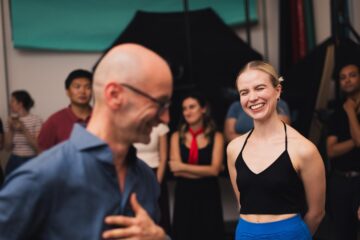“Boleo” or “Voleo”?
In Spanish, the “b” and “v” sounds are much closer in pronunciation, so they are often interchanged in writing. This is one reason we encounter both forms. The other reason is related to the etymological dilemma of the word. Some say it comes from the verb “bolear” = to throw, while others trace it to “volar” = to fly. Both have legitimacy, but in my experience, “boleo” is the more common form.
What is a “Boleo”?
It is a movement where the body (axis/center/lead…) stops or changes direction, but due to inertia, the free leg continues to swing.
Whew. It wasn’t easy to cobble together this definition, I admit. There are many types of boleos, with different techniques, styles, and concepts, and over time, certain changes can be observed. I tried to gather them into a bouquet, listing examples and short explanations. I hope this makes the definition clear and complete, and gives us a relatively clear picture of this “what-do-you-call-it” in question.
First, let’s look at the different grouping possibilities.
Front or Back:
The free leg swings either in front of or behind the standing leg.
(I wonder if there is a side boleo… Because why not?)
Straight or Circular:
A linear boleo is a straight-line movement where the free leg continues straight, usually stemming from a step or projection.
A circular boleo involves an over-rotated pivot where the free leg continues its path around the axis. In a front boleo, it “wraps around” the standing leg, and in a back boleo, it targets the opposite side’s butt (yes, BUTT. Any questions?).
"A Favor" or Contra:
The lead of the boleo is “a favor” or in the same direction when the leader just stops their movement, while in a contra, they also move in the opposite direction. The former is like throwing a ball, the latter like a whip or yo-yo. In “a favor,” more energy is usually put into preparing the boleo, felt in the step or pivot.
In contra, the emphasis is later, and the boleo “surprises” during the projection or pivot. That’s why, in circular contra boleo, the free leg draws an arc even in the descending phase, as it still carries momentum, while in “a favor,” it usually just drops straight down. Timing and coordination, as well as maintaining the flexibility and rubber-like quality of the movement, are important in both. (Note: Contra boleos often start with an “a favor” movement.) Initially, contra leading was more common, but nowadays, the “a favor” technique is becoming more popular.
Low or High:
In a low boleo, the free leg stays on or close to the ground. Some don’t even consider this a boleo but a planeo. Here too, it’s a question of whether to classify it by form or mechanics, looking at the lead or execution. (For me, it’s a boleo if it has the elastic rubber band feeling and the free leg lags.
If it moves with the axis like a compass, I also call it a planeo.)
Closed Knees or Not?
I think this is primarily the executor’s decision. In the past, it was danced with closed knees, partly due to the sudden contra lead popular at the time, the fashion (aesthetically and literally – wearing tighter clothes), and more crowded dance floors. Physical fitness (warming up, stretching) also affects how high one can swing their leg – be mindful of this while dancing, as well as your surroundings and partner!
"Seesaw" Boleo:
As one side of the seesaw – our upper body – moves down, the other side – the free leg – moves up.
Led Boleo or Decoration?
● The leader guides the follower’s boleo with a technique.
● The leader doesn’t specifically lead the boleo but provides space and time for it.
● The follower suggests the boleo, initiating it, ideally the leader “clicks” and joins in.
● The follower or leader incorporates the boleo into their dance without affecting the other’s movement.
Gancho:
More Tips:
My personal experience is that I practiced boleos a lot (e.g., at bus stops 😊) and it took a long time (years…) before I started to come to terms with them after much dissatisfaction. Based on my struggles, I find it important in led-followed boleos not to rush them, not to let the brain move the leg, but to let the movement flow through the body, happening based on physical laws. This requires more time, patience, and practice, as we need to learn which muscles to use or relax at what time. Ensure that the connection with your partner remains during the boleo, as a follower, continuously communicate to your partner what is happening in your body, don’t try to “hide” it, and as a leader, participate in the other’s movement, follow it through, so you’ll know exactly when and how to continue with the next move. Naturally, we also need to find the place for boleos in the music, but that’s truly another chapter!
We welcome any comments or additions, and happy boleoing! 😊


